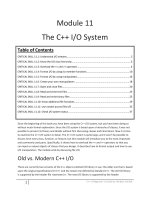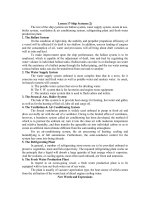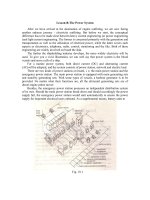Vietnamese Writting System
Bạn đang xem bản rút gọn của tài liệu. Xem và tải ngay bản đầy đủ của tài liệu tại đây (99.35 KB, 20 trang )
Vietnamese writing systems
Group 8
1. Nguyễn Thị Quế Hương
2. Phạm Thị Mỹ Loan
3. Trần Thị Như Thơ
4. Nguyễn Thị Ngọc Huyền
5. Trần Thùy Tiên
6. Phạm Thị Thanh Trang
Instructor: Mr Lê Minh Hà
Vietnamese writing system: where from and
how
I. Where did Vietnamese writing systems
come from?
1. Switching the national writng system
from Chinese characters (Hương)
2. Inventions about alphabet’s system of
Jesuit missionaries (Loan)
II. How was Vietnamese writing system
developed?
1. Chu Viet Co (Thơ)
2. Chu Han (Thơ)
3. Chu Nom (Huyền)
4. Chu Quoc Ngu (Trang)
III.Summary (Tiên)
I. Where did Vietnamese writing system
come from?
-Vietnamese writing system, which was
developed, based on:
• Chinese characters ( Hán Nho)
• The invention of alphabetic system of
Jesuit missionaries
1. Chinese characters
- Vietnam was colonized around 200 B.C
– about 12 centuries
- Chinese character was used in writing
while Vietnamese unwritten
- Chinese character had a massive
influence on Vietnamese language and
literature
- A huge proportion of the modern
vocabulary has its origins in Chinese
Ex: Bình ngô đại cáo ( chữ hán:平吳大誥)
- 1788-1802: The Tay Son Dynasty, under
Nguyen Hue, Quang Trung
- They had switched the national writing
system from Han Nho ( Chinese character)
to the more Vietnamese writing system of
Nom (Vietnamese character)Nom character
2. Inventions about alphabet system of
Jesuit missionaries
- At the beginning of the seventeen century,
Jesuit missionaries devised an alphabet
system for Vietnamese.
- Alaxan de Rhoses (born at Avignon in
1591, died at ispahan,Persia, in 1660) who
spent six years in Vietnam(1624-1630) for
his catholic missions, had done to introduce
a system of Roman writing into Vietnamese
language.
Continuing the efforts of Portuguese Jesuit
missionaries like Francisco de Pina, Gaspar
d’Amaral, Antonio Barbosa,etc.
Alaxan de Rhoses published the first
Vietnamese catechist and the first
Vietnamese-latin-Portuguese dictionary
(Rome, 1651). This writing is called “quốc
ngữ”(national language)
- Jesuit missionaries used signs of Greece to
present rhythm and “quốc ngữ” was affected
by Portuguese writing: consonant sound (gi,
ch, x, nh);vowel sound(â, ê, ô)
- Vietnamese gradually adopted, partly
under pressure from the French colonial
government.
- Today, the system devised by Jesuit is only
one in use for Vietnamese.
II. How was Vietnamese writing system
developed ?
1. Chu Viet Co (chu Khoa Dau, chu Vua
Hùng)
According to Ha Van Tan, Le Trong Khanh,
Buu Cam,and Đo Quang Vinh professor
confimed: under Hung King, writing system
is the same as tadpole shape
In january 2013, Do van Xuyen researcher
pulished a book that the title is “ cuộc hành
trình đi tìm chữ Việt cổ”
That is a result after many years he tried to
find.
Although noone hasn’t agreed, this is a
good sign in a dream that finding out
ancient writing.
For example: Hich Khoi Nghia was
translated by him.
However, Chu viet co was lost after Hai
Ba Trung’s uprising was failed.
2. Chu Han
For much of Vietnam's history the official
written language was Classical Chinese,
using, of course, Chinese characters.
For example:
Since 1st AD: Chu Han was used in record
and communication with China
From 7th to 11th century: Chu Han was used
more widely in Viet Nam (communication,
trade, and economic exchanges with China)
After 10th century: Viet Nam was
independence. Chu Han was still used.
( examination, literature )
Nguyen Tieu and Hich tuong si was written
by Chu Han. Chieu doi do and Dai Viet Su
luoc was also written by chu Han
Even now, Vietnamese still borrows many
words which belonged to Chinese writing
system.
Examples:
The word sơn meaning 'mountain' was
written 山 (modern Chinese shān).
The word hỏa meaning 'fire' was written 火
(modern Chinese huǒ).
The word vị meaning 'flavour' was written
味 (modern Chinese wèi).
NOTES:
The King, mandarins, intellectuals,…used
Chu Han in communication, literature,…
Vietnamese people used vietnamese
language to communicate together.(mon-
kmer, mường…)
3. Nom character
Definition :Nôm character is the ancient
ideographic vernacular script of the
Vietnamese language.
The ideographic is a form of writing in
which a written symbol represents an object
rather than a word or speech sound.
Vernacular is the same meaning with either
native or indigenous.
There are some features of nom character:
• Nom character was the system developed
to write Vietnamese.
• The actual date is not agreed but nom
character was already in existence by the
mid-13th century.
• Nom character had used the mixture of
standard Chinese characters and new
character invented specifically for
Vietnamese pronunciation.
• Nom character was not the completely
new system of writing.
• It is more complex and unwieldy than its
origin.
• Nom character contained two elements:
one gives the meaning and another hints
at the Vietnamese pronunciation.
How to create nom character :
People had used 3 methods to create Nom
character:
• Combinition between a meaning
element and a sound element.
Native
Vietnamese
Word
Chu
Nom
Characte
r
Chineses
Component
s
Function
Núi
'mountain'
山
內
Meaning
('mountain')
Sound (nèi in
modern
Mandarin)
lửa
'fire'
火
呂
Meaning ('fire')
Sound (lǚ in
modern
Mandarin)
lạ
'strange'
羅
奇
Sound (luó in
modern
MandarinMeanin
g ('strange')
• Combination of two meanings:
Native
Vietnamese
Word
Nom
characte
r
Chinese
components
Function
trời
'sky, heaven'
天
上
Meaning
('heaven')Mea
ning ('above')
• Modification of existing character
chosen for its sound:
Native
Vietnames
e word
Nom
characte
r
Chinese
component
s
Function
ấy
'that'
Sound
only (yī in
modern
Mandarin)
; original
meaning
is
irrelevant
• Also, people had used Chinese
characters without change.
The word sơn meaning 'mountain' was
written 山 (modern Chinese shān).
The word hỏa meaning 'fire' was written 火
(modern Chinese huǒ).
The word vị meaning 'flavour' was written
味 (modern Chinese wèi)
4. Chu Quoc ngu:
Quoc ngu was largely neglected until the
19th century when it was taken up by the
French colonial government as a means of
breaking the grip of Chinese culture and
fostering Western ways of thinking.
• Quoc ngu is based on a system devised
by Alexander de Rhodes
• Modern Vietnamese is written with the
Latin alphabet, known as quoc ngu (quốc
ngữ) in Vietnamese. Quoc ngu consists of 29
letters. These are:
The 26 letters of the English alphabet
minus f, j, w, and z.
Seven modified letters using diacritics: đ,
ă, â, ê, ô, ơ, and ư
" Con gno muon bau tlom laom Hoalaom
chian " is considered the first characters of
Quoc ngu.
• According to Christofora Borri, it means
“Con nhỏ muốn vào trong lòng Hoa Lang
chăng”.
Some conventions of Christofora Borri in
recording Vietnamese:
+ “gn” replaces for “nh”, “b” replaces for
“v”, “tl” replaces for “tr”, “m” replaces for
“ng”, “sc” replaces for “x”,…
+ At that time, tones were not completed.
Some modified letters were placed at the
end the word instead of accent marks: “j”
replaces for acute accent and tilde, “o”
replaces for hook above
Ex:
Onsaij : Ông sãi
Quignin : Qui Nhơn
Scin mocaij : Xin một cái
Con gnoo : Con nhỏ
Doij : Đói
Nuocmon : Nước mặn
Tui ciam biet : Tui chẳng biết
Bũa : Vua
Onsaij di lay : Ông Sãi đi lại
Single word and struture:
o A single word signifies a single thing,
action, condition, mood, state, etc
o A Vietnamese word is structured with
four parts: initial, core, final and tone:
For example:
Tâm (t: initial part, â: core, m: final part)
-> this word has no tone.
Mình (m: initial part, i: core, nh: final
part)
-> this word has low falling tone.
The final part can be one of the eight finals:
-c, -ch, -m, -n, -ng, -nh, -p, -t or none.
• Loan word:
long tradition Vietnamese of transforming
foreign words into an acceptable Vietnamese
form:
frein 'brake‘ phanh
Film phim
café 'coffee‘ cà phê
carotte 'carrot‘ cà rốt
• Modern borrowings:
'guitar' written ghi ta, ghi-ta, ghita, or guitar.
'video' may be written vi-đe-ô, vi-đi-ô, or
video.
III. Sumary
Vietnamese writing systems:
Spending a long time to establish and
improve
Developing based on 3 elements:
Han character
Nom character
Alphabet’ system
1. Han character:
It was used popularly in the examination,
literature, communication in the court.
It was still used after independence.
2. Nôm character:
It was more complicated and based on Han
character to develope.
It presented the traditional Vietnamese’s
culture
3. Quoc ngu:
it was shown by some missionaries at 17
centuries
and it became the vietnamese writing
system.
4. Especially:
Nowaday, new writing seem to be popular:
the young use the most this new writing.
For example:
nhìu chiện : nhiều chuyện
wa’ : quá
hỉu bik : hiểu biết
“T.s a lại đx vs e nt, a có biết là hn e buồn
lắm k? Có lẽ chúng ta sắp ct thật r`”.
=> “Tại sao anh lại đối xử với em như thế,
anh có biết là hôm nay em buồn lắm không?
Có lẽ chúng ta sắp chia tay thật rồi”
“Mai m` k đh đâu nha m.n”.
=> “mai mình không đi học đâu nha mọi
người”









